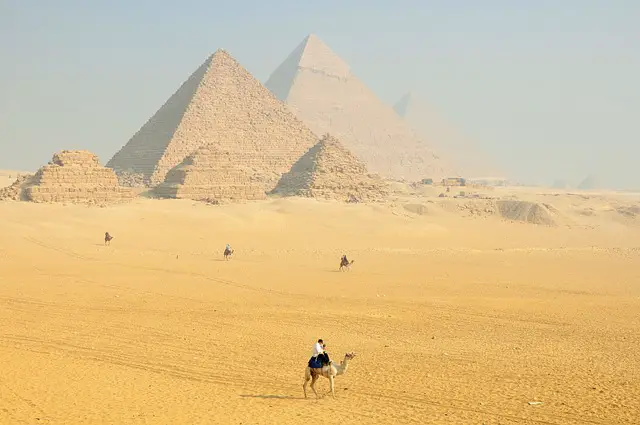
Welcome to an enthralling journey through the captivating tapestry of Egypt’s illustrious history.
The Egyptian civilization boasts a timeline that spans millennia, and it’s a narrative brimming with extraordinary accomplishments, enigmatic enigmas, and cultural wonders.
In this article, we’ll embark on a quest to unveil the intriguing epochs that define the remarkable Egyptian civilization timeline.
From the earliest dawns of the Early Dynastic Period to the echoes of the Roman conquest and beyond, we’ll immerse ourselves in the pivotal eras that have indelibly etched Egypt’s enduring legacy.
Early Dynastic Period (c. 3100–2686 BCE)
Our adventure commences in the Early Dynastic Period, approximately around 3100 BCE.
This pivotal era witnessed the unification of Upper and Lower Egypt under the rule of King Menes.
It laid the very foundations for Egypt’s dynastic rule.
Notably, this period saw the invention of hieroglyphs, the intricate system of writing that would chronicle Egypt’s story for millennia.
Additionally, it marked the construction of iconic structures like the Step Pyramid of Djoser, showcasing the architectural prowess of ancient Egyptians.
- Read also: 10 Fascinating Egyptian Mythology Facts
- Read also: Unraveling the Mysteries of Ancient Egyptian Tombs
Old Kingdom (c. 2686–2181 BCE)
Let’s journey onward to the renowned Old Kingdom, which graced the annals of history from approximately 2686 to 2181 BCE.
This era is celebrated for its monumental feats, with none more iconic than the awe-inspiring construction of the Great Pyramids of Giza.
These colossal marvels bear testimony to the unparalleled engineering prowess of ancient Egyptians, serving as timeless monuments to human achievement.
However, the Old Kingdom’s influence extended far beyond architecture, as it also witnessed a vibrant flourishing of the arts, literature, and culture, leaving an indelible and resplendent mark on the tapestry of human history.
First Intermediate Period (c. 2181–2055 BCE)
Following the splendor of the Old Kingdom, we encounter the tumultuous First Intermediate Period, lasting from around 2181 to 2055 BCE.
This was a time of political upheaval and decentralization, characterized by regional rulers and power struggles that reshaped the political landscape of ancient Egypt.
Middle Kingdom (c. 2055–1650 BCE)
Our journey now takes us to the Middle Kingdom, spanning approximately from 2055 to 1650 BCE.
This remarkable period ushered in a sense of stability and cultural resurgence in ancient Egypt.
Pharaohs of this era embarked on ambitious building projects, leaving behind enduring monuments that still awe us today.
But it wasn’t just about grand architecture; it was a time when Egyptian literature truly thrived.
Classic works like “The Tale of Sinuhe” emerged, offering a window into the artistic and intellectual vitality of this age.
Second Intermediate Period (c. 1650–1550 BCE)
Our path then leads us into the challenging times of the Second Intermediate Period, which unfolded between roughly 1650 and 1550 BCE.
This period in Egypt’s history was marked by invasions and occupation by the Hyksos, a foreign group.
Egypt’s sovereignty faced significant threats and fluctuations during this tumultuous chapter.
New Kingdom (c. 1550–1070 BCE)
The grandeur of the New Kingdom awaits as we venture into the period from around 1550 to 1070 BCE.
Often referred to as the Golden Age of Egypt, this era witnessed the reign of mighty pharaohs, including the illustrious Ramses II.
It was an age of unparalleled prosperity and power for Egypt.
Grand temples and monuments were constructed on a grand scale, attesting to the empire’s opulence and influence in the region.
Third Intermediate Period (c. 1070–712 BCE)
Our journey through Egypt’s complex history brings us to the Third Intermediate Period, spanning from around 1070 to 712 BCE.
This era was characterized by instability and division, as foreign rule and internal conflicts cast a shadow over the land of the pharaohs.
It marked a significant turning point, signaling the gradual decline of the New Kingdom’s once-glittering splendor.
Late Period (c. 712–332 BCE)
As we proceed through the sands of time, we encounter the Late Period, spanning approximately from 712 to 332 BCE.
During this period, native Egyptian rule experienced a resurgence, with the establishment of notable dynasties such as the 26th dynasty.
However, Egypt’s fate remained entwined with foreign invasions, notably by the Persians and Greeks, which added layers of complexity to its historical narrative.
Ptolemaic Period (c. 332–30 BCE)
Our voyage concludes with the intriguing Ptolemaic Period, which unfolded approximately between 332 and 30 BCE.
This captivating epoch marked Egypt’s transition into a Ptolemaic kingdom, a transformation instigated by the conquests of the legendary Alexander the Great.
It stands as an era of captivating cultural fusion, where the influence of Greek civilization seamlessly intertwined with the rich tapestry of Egyptian traditions.
At the heart of this captivating interplay was the city of Alexandria, renowned not only for its grandeur but also for its illustrious library and vibrant intellectual milieu.
Together, these elements encapsulated the essence of a unique and dynamic blend that defined this distinctive period.
Roman Period (30 BCE–641 CE)
Our odyssey through Egypt’s storied past takes us to the Roman Period, which unfolded from 30 BCE to 641 CE.
During this epoch, Egypt became a Roman province, ushering in an intriguing blend of Roman and Egyptian cultures.
This fusion gave rise to a fascinating cultural tapestry, as Roman governance left its mark on the land of the Nile.
Yet, as time advanced, Egypt’s civilization began to face challenges and decline, influenced by a multitude of factors that would shape its historical trajectory.
- Read also: Tomb Robbing in Ancient Egypt
- Read also: Who is Anubis in Egyptian Mythology
Conclusion
The journey through the timeline of Egyptian civilization is truly captivating, spanning countless millennia marked by remarkable human achievements, innovative strides, and a profound cultural wealth.
It serves as an eloquent testament to the timeless legacy of a civilization that has etched its indelible mark into the pages of history.
From the majestic pyramids that pierce the vast desert skies to the enduring wisdom enshrined within ancient scrolls, Egypt’s contributions to our world continue to hold us spellbound and ignite our inspiration.
As we contemplate this extraordinary heritage, we are reminded of the limitless bounds of human creativity and the enduring fascination that a civilization, as monumental as Egypt’s, holds in the collective imagination of our world.
FAQs
Hieroglyphs were the ancient Egyptian writing system, used for inscriptions, religious texts, and more. They played a crucial role in preserving Egyptian history and culture.
The construction of the pyramids involved a massive workforce of laborers and skilled artisans. They used a combination of ramps, levers, and sheer determination to build these incredible structures.
Several factors contributed to the decline, including external invasions, internal strife, and economic challenges. The exact reasons remain a subject of historical debate.



